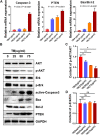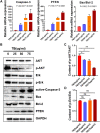Theabrownin Induces Cell Apoptosis and Cell Cycle Arrest of Oligodendroglioma and Astrocytoma in Different Pathways
- PMID: 33995088
- PMCID: PMC8119995
- DOI: 10.3389/fphar.2021.664003
Theabrownin Induces Cell Apoptosis and Cell Cycle Arrest of Oligodendroglioma and Astrocytoma in Different Pathways
Abstract
Theabrownin (TB), a natural compound present in the fresh leaves of green tea, is a potential antitumor agent. However, so far whether and how TB affects glioma is unclear. In this study, we investigated the effect of TB on astroglioma and oligodendroglioma cells. Surprisingly, TB significantly reduced the viabilities of HOG and U251 cells in a dose-dependent manner, which was accompanied by the upregulation of active-Casp-3, Bax, and PTEN; meanwhile, the antiapoptotic gene Bcl-2 was downregulated. In addition, TB treatment induced cell cycle arrest at the G1 and G2/M phases in HOG and U251 cells, respectively. TB treatment caused the downregulating of c-myc, cyclin D, CDK2, and CDK4 and upregulating of p21 and p27 in the HOG cell, while TB increased P53, p21, and p27 levels and decreased the levels of cell cycle regulator proteins such as CDK and cyclin A/B in the U251 cells. Therefore, the c-myc- and P53-related mechanisms were proposed for cell cycle arrest in these two glioma cell lines, respectively. Overall, our findings indicated that TB could be a novel candidate drug for the treatment of gliomas.
Keywords: apoptosis; astrocytoma; cell cycle; oligodendroglioma; theabrownin.
Copyright © 2021 Fu, Jiang, Wu, Mei, Yang, Tao, Chen, Zhang, Huang and Zhao.
Conflict of interest statement
Author JZ was employed by the company Theabio Co., Ltd. The remaining authors declare that the research was conducted in the absence of any commercial or financial relationships that could be construed as a potential conflict of interest.
Figures









Similar articles
-
Theabrownin Inhibits Cell Cycle Progression and Tumor Growth of Lung Carcinoma through c-myc-Related Mechanism.Front Pharmacol. 2017 Feb 27;8:75. doi: 10.3389/fphar.2017.00075. eCollection 2017. Front Pharmacol. 2017. PMID: 28289384 Free PMC article.
-
Lovastatin mediated G1 arrest in normal and tumor breast cells is through inhibition of CDK2 activity and redistribution of p21 and p27, independent of p53.Oncogene. 1998 Nov 5;17(18):2393-402. doi: 10.1038/sj.onc.1202322. Oncogene. 1998. PMID: 9811471
-
β-Asarone Induces Apoptosis and Cell Cycle Arrest of Human Glioma U251 Cells via Suppression of HnRNP A2/B1-Mediated Pathway In Vitro and In Vivo.Molecules. 2018 May 3;23(5):1072. doi: 10.3390/molecules23051072. Molecules. 2018. PMID: 29751524 Free PMC article.
-
Induction of p21(Waf1/Cip1) by garcinol via downregulation of p38-MAPK signaling in p53-independent H1299 lung cancer.J Agric Food Chem. 2014 Mar 5;62(9):2085-95. doi: 10.1021/jf4037722. Epub 2014 Feb 24. J Agric Food Chem. 2014. PMID: 24533688
-
Myc and the cell cycle.Front Biosci. 1998 Feb 15;3:d250-68. doi: 10.2741/a239. Front Biosci. 1998. PMID: 9468463 Review.
Cited by
-
Theabrownin Alleviates Colorectal Tumorigenesis in Murine AOM/DSS Model via PI3K/Akt/mTOR Pathway Suppression and Gut Microbiota Modulation.Antioxidants (Basel). 2022 Aug 30;11(9):1716. doi: 10.3390/antiox11091716. Antioxidants (Basel). 2022. PMID: 36139789 Free PMC article.
-
Qingzhuan dark tea Theabrownin alleviates hippocampal injury in HFD-induced obese mice through the MARK4/NLRP3 pathway.Heliyon. 2024 Feb 28;10(5):e26923. doi: 10.1016/j.heliyon.2024.e26923. eCollection 2024 Mar 15. Heliyon. 2024. PMID: 38455533 Free PMC article.
-
Theabrownin Isolated from Pu-Erh Tea Enhances the Innate Immune and Anti-Inflammatory Effects of RAW264.7 Macrophages via the TLR2/4-Mediated Signaling Pathway.Foods. 2023 Mar 30;12(7):1468. doi: 10.3390/foods12071468. Foods. 2023. PMID: 37048289 Free PMC article.
-
Beta-glucans in oncology: revolutionizing treatment with immune power & tumor targeting.Naunyn Schmiedebergs Arch Pharmacol. 2025 Aug 27. doi: 10.1007/s00210-025-04519-8. Online ahead of print. Naunyn Schmiedebergs Arch Pharmacol. 2025. PMID: 40864254 Review.
-
Diosbulbin C, a novel active ingredient in Dioscorea bulbifera L. extract, inhibits lung cancer cell proliferation by inducing G0/G1 phase cell cycle arrest.BMC Complement Med Ther. 2023 Dec 4;23(1):436. doi: 10.1186/s12906-023-04245-9. BMC Complement Med Ther. 2023. PMID: 38049779 Free PMC article.
References
-
- Boulaire J., Fotedar A., Fotedar R. (2000). The Functions of the Cdk-Cyclin Kinase Inhibitor p21WAF1. Pathol. Biol. (Paris) 48 (3), 190–202. - PubMed
LinkOut - more resources
Full Text Sources
Other Literature Sources
Research Materials
Miscellaneous

